AUDI A7 2013 Owners Manual
Manufacturer: AUDI, Model Year: 2013, Model line: A7, Model: AUDI A7 2013Pages: 310, PDF Size: 77.45 MB
Page 221 of 310
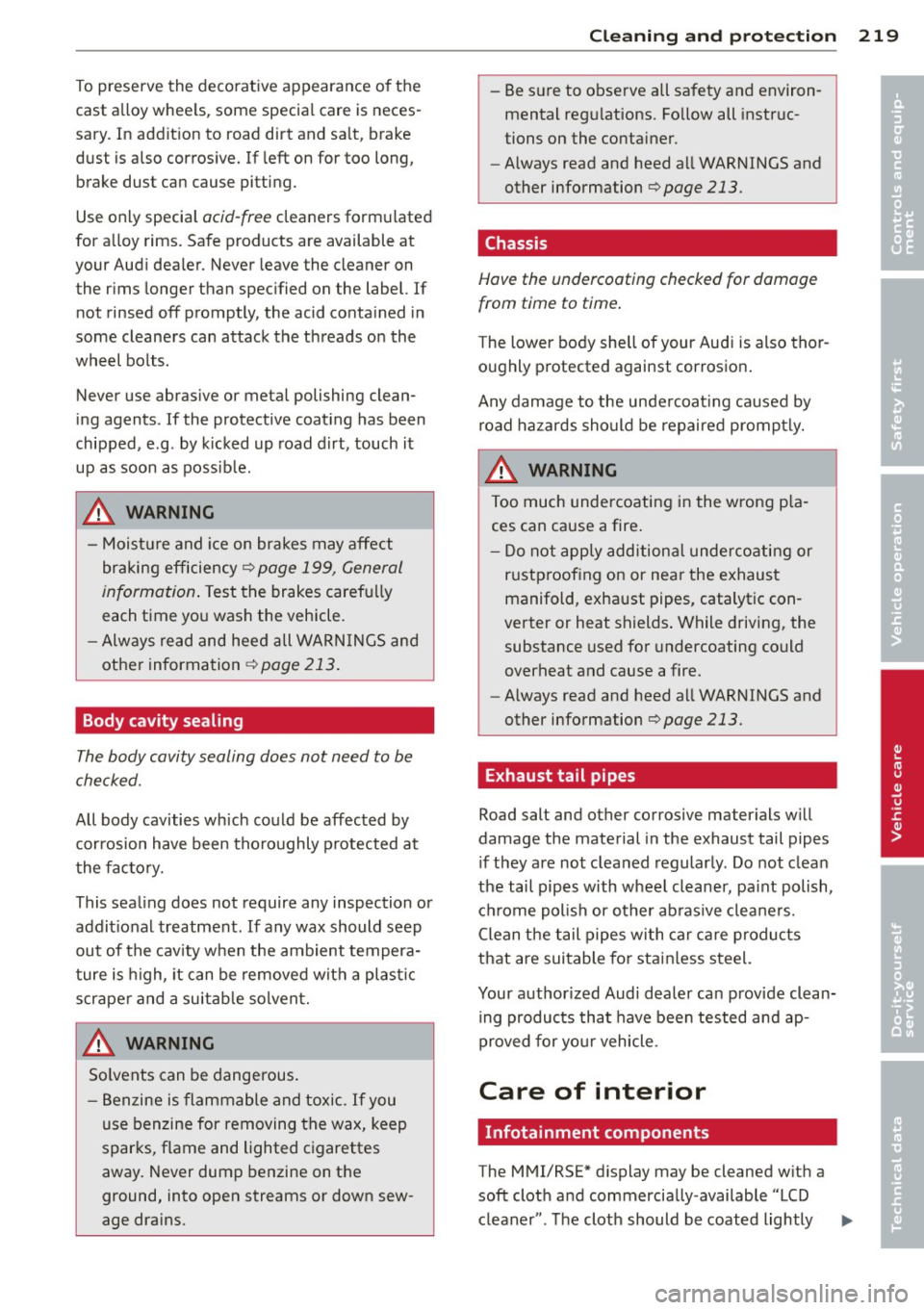
To preserve the decorative appearance of the
cast a lloy whee ls , some specia l care is neces
sary. In add it ion to road dirt and sa lt, brake
dust is also corros ive. If left on for too long,
brake dust can cause pitting.
Use only specia l
acid-free cleaners formulated
for a lloy rims. Safe products are available at
your Aud i dealer. Never leave the cleaner on
t he r ims longer than spec ified on the label. If
not rinsed off promptly, the acid conta ined in
some cleaners can attack the threads on the
wheel bo lts.
Never use abras ive or metal polishing clean
ing agents . If the protective coat ing has been
chipped, e .g . by k icked up road d irt, touch it
up as soon as possib le.
.8, WARNING
- Moist ure and ice on brakes may affect
braking efficiency
r::!;> page 199, General
information .
Test the brakes caref ully
each time you wash the vehicle.
- Alw ays read and hee d all WARN INGS and
other information ¢
page 213 .
-
Body cavity sealing
The body cavity sealing does not need to be
checked.
All body cavities wh ich could be affected by
corrosion have been thoroughly p rotected at
the facto ry.
This sea ling does not require any inspection or
addit ional treatment . If any wax should seep
out of the cav ity w hen the ambient tempera
ture is high, it can be removed wit h a plastic
scrape r and a su itab le solvent.
.8, WARNING
So lvents can be dangerous.
- Benzine is flammable and toxic.
If you
u se benzine for removing the wax, keep
sparks, flame and lighted c igarettes
away. Never dump benzine on t he
ground, into open streams or down sew
age drains .
Cleaning and protec tion 219
- Be s ure to observe all safety and environ
mental reg ulations . Follow all instruc
tions on the container.
- Always read and heed a ll WARNINGS and
other information
r::!;> page 213.
Chassis
Have the undercoating checked for damage
from time to time .
The lower body shell of your Aud i is also thor
oughly protected against corrosion .
A ny damage to the unde rcoa ting caused by
road hazards sho uld be repaired prompt ly.
.8, WARNING ,.____
T oo much undercoating in the wrong p la
ces can cause a fire.
- Do not app ly addition al u nder coati ng or
r u stp roof ing on or nea r the exhaust
manifold, exhaust pipes, catalytic con
verter or heat shields . While driving, the
substance used for undercoating could
overheat and cause a fire.
- Always read and heed a ll WARNINGS and
other information
r::!;> page 213.
Exhaust tail pipes
Road salt and other corrosive materials will
damage the material in the exhaust tail pipes
if they are not clea ned regular ly . Do not clea n
the tail pipes with w heel cleaner, pa int polish,
c hr ome polish or other ab ras ive clea ne rs.
C lean t he tail pipes with ca r c are products
that are suitable for stainless steel.
Your authorized Audi dea ler ca n provide clean
ing products that have been tested and ap
proved for yo ur vehicle .
Care of interior
Infotainment components
The MMI/RSE* display may be cleaned w it h a
soft clot h and commercia lly-available "LCD
cleaner" . T he cloth should be coated lightly .,..
•
•
Page 222 of 310
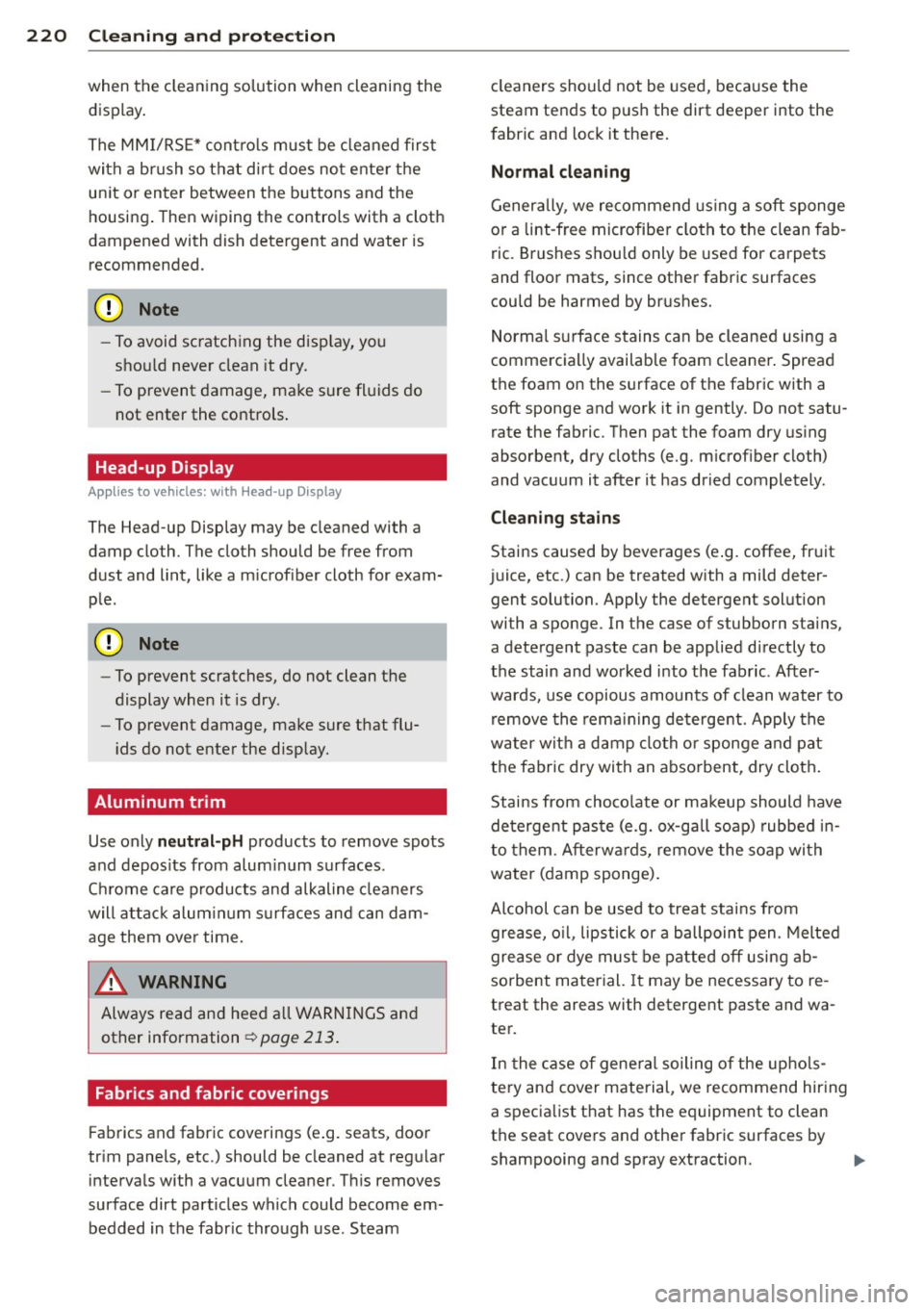
220 Cleaning and protec tio n
when the cleaning so lution when cleaning the
display .
The MMI/RS E* contro ls must be cleaned first
with a brush so that d irt does not enter the
unit or enter between the buttons and the
housing . Then wiping the controls with a cloth
dampened with dish detergent and water is
recommended.
- To avoid scratching the disp lay, you
shou ld never clean it dry.
- To prevent damage, make sure fl uids do
not enter the controls .
Head-up Display
Applies to vehicles: with Head-up Display
The Head-up Display may be cleaned with a
damp cloth. The cloth should be free from
dust and lint, like a m icrofiber cloth for exam
ple .
Q) Note
-To prevent scratches, do not clean the
display when it is dry.
- To prevent damage, make sure that flu
i ds do not enter the disp lay.
Aluminum trim
Use only n eutral -pH products to remove spots
and depos its from alum inum surfaces .
Ch rome ca re products and alkaline cleaners
will attack alum inum s urfaces and can dam
age them over time.
A WARNING
Always read and heed a ll WARNINGS and
other information ¢
page 213.
Fabrics and fabric coverings
Fabrics and fabric coverings (e .g. seats, door
tr im panels, etc.) should be cleaned at reg ular
intervals with a vacuum cleaner . This removes
surface dirt particles which could become em bedded in the fabr ic through use . Steam cleaners should not be
used, because the
steam tends to p ush the dirt deeper into the
fabric and lock it there.
Normal cl eaning
Genera lly, we recommend using a soft sponge
o r a lint-free microfiber cloth to the clean fab
ric. Brushes shou ld only be used for carpets
and floor mats, since other fabric surfaces cou ld be harmed by brushes.
Normal s urface stains can be cleaned using a
commercially availab le foam cleaner . Spread
the foam on the surface of the fabric with a soft sponge and work it in gently . Do not satu
rate the fabric. Then pat the foam dry us ing
absorbent, dry cloths (e.g. m icrofiber cloth)
and vacuum it after it has dried completely.
Cle aning stains
Stains caused by beverages (e .g. coffee, fruit
juice, etc .) can be treated with a mild deter
gent solution. Apply the detergent solution
wi th a sponge. In the case of stubborn s tains,
a detergent paste can be applied directly to
the stain and worked i nto the fabric . After
wards, use copious amounts of clean water to
remove the rema ining deterge nt. Apply the
water with a damp cloth or sponge a nd pat
the fabr ic dry with an absorbent, dry cloth .
Stai ns from choco late or makeup should have
detergent paste (e.g. ox-gall soap) rubbed in
to them. Afterwa rds, remove the soap with
water (damp sponge) .
Alcohol can be used to treat stains from grease, o il , lipstick or a ballpoint pen . Melted
gre ase or dye mus t be patted
off using ab
sorbent material. It may be necessary to re
treat the areas with detergent paste and wa
ter.
In the case of general soiling of the upho ls
te ry and cover material, we recommend hiring
a specia list that has the equipment to clean
the seat covers and other fabric surfac es by
shampooing and spray extraction.
Page 223 of 310
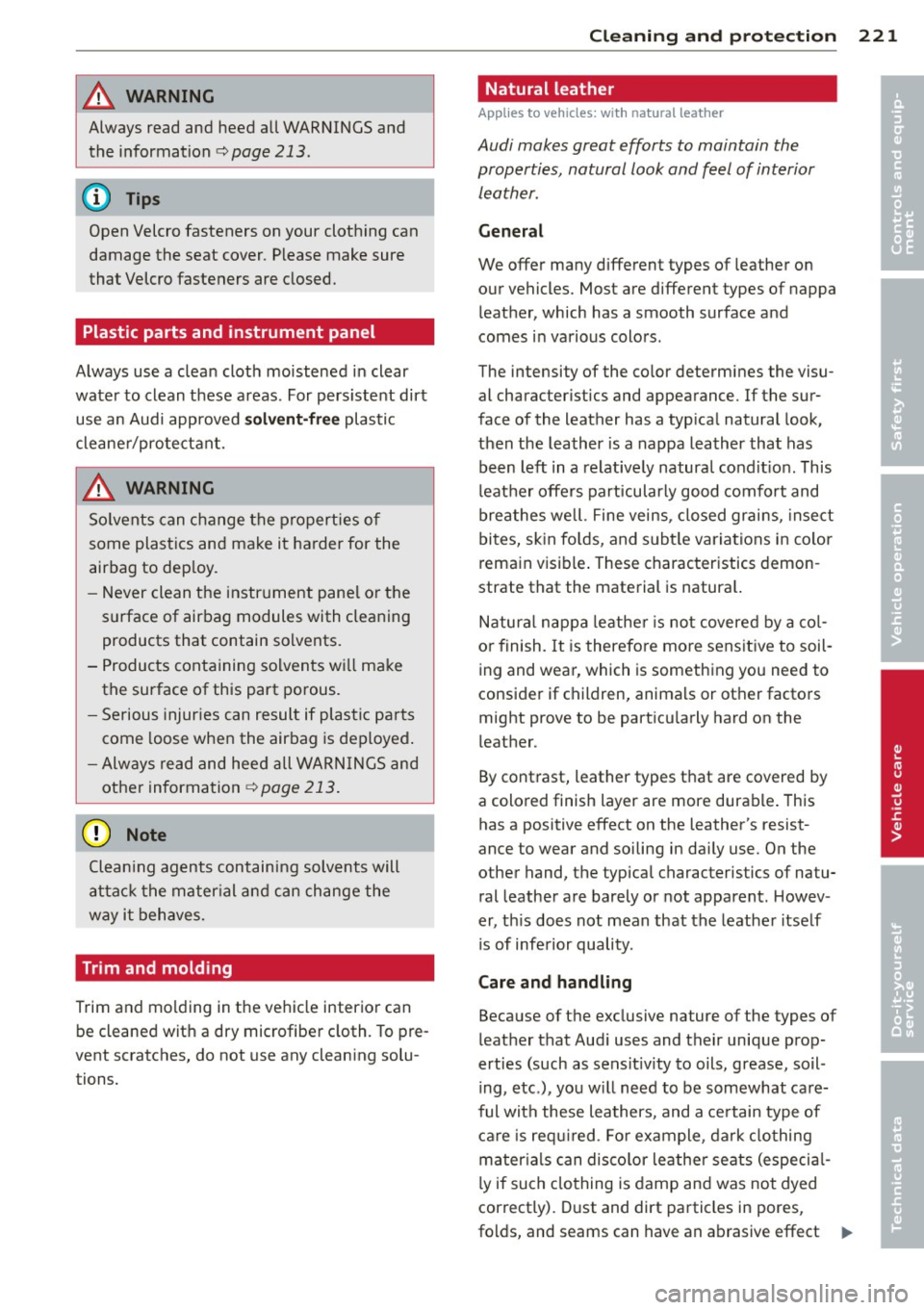
A WARNING ,~
Always read an d heed all WARNINGS and
the information
c';> page 213.
(D Tips
Open Velcro fasteners on your clothing can
damage the seat cover . Please make sure
that Velcro fasteners are closed.
Plastic parts and instrument panel
Always use a clean cloth moistened in clear
water to clean these areas . For pers istent dirt
use an Audi app roved
s olvent-fr ee plastic
cleane r/pro te ctant.
A WARNING
So lvents can c ha n ge the properties o f
some plast ics and make it ha rder for the
airbag to dep loy.
-
- N ever clean the instr ument pane l o r the
s u rface of airbag modules with clea ning
products that contain solvents.
- Products containing solvents w ill make
the surface of this part porous.
- Serious injur ies can resu lt if plastic pa rts
come loose when the airbag is deployed .
- Alw ays re ad and hee d all WAR NINGS and
other informa tion
c:';> page 213.
(D Note
Clea ning agents containing solvents will
atta ck th e mater ial a nd can change the
way it behaves.
Trim and molding
Trim and mo lding in the ve hicle interio r can
be cleaned w it h a dry microfibe r cloth. To pre
vent scratches, do not use any clean ing solu
t ions.
Cleaning and protec tion 221
Natural leather
Applies to vehicles: with natural leather
Audi makes great efforts to maintain the
properties, natural look and feel of interior
leather .
General
We offer many different types of leather o n
our vehicles. Mos t are different types of nappa
l eather, which has a smooth surface and
comes in various colo rs .
The intensity of the co lor determines the visu
al characteristics and appearance. If the sur
face of the leather has a typ ica l natural look,
t h en the leather is a nappa leather that has
been left in a re lative ly natura l condit io n . This
leat her offe rs particularly good comfort and
brea thes we ll. Fine veins , cl osed grai ns, in sect
bites, sk in fo lds, and s ubt le var ia tions in co lor
rema in visible . These charac teristics demon
strate that the material is natura l.
Natura l n a p pa le athe r is no t covered by a col
o r finish. It is therefo re more sens it ive to soil
ing and wea r, which is someth ing you need to
consider if children , anima ls or ot her facto rs
might prove to be pa rt icu larly hard on the
leat her .
By cont rast, leather types t hat are covered by
a colo red finish layer are more durab le . T his
has a positive effect on the leather's resist
ance to wear and soiling in dai ly use. On the
other hand, the typical characteristics of na tu
ral leathe r are barely or not apparent. Howev
er, th is does not mean that the leathe r itse lf
is of infe rior quality .
Care and handling
Because of the exclusive nature of the types of
leat her that Aud i uses and their unique p rop
erties (such as sens it iv ity to oils, grease , soil
ing, etc.), yo u w ill need to be somewhat ca re
ful with these leathers, and a ce rtain type of
ca re is req uired. Fo r exam ple , da rk clothing
m at eria ls can dis co lor le ather seats (especi al
ly if su ch clo thing is damp and was not dyed
correct ly). Dust and dirt particles in pores,
fo lds, and seams can have an abrasive effect .,.. •
•
Page 224 of 310
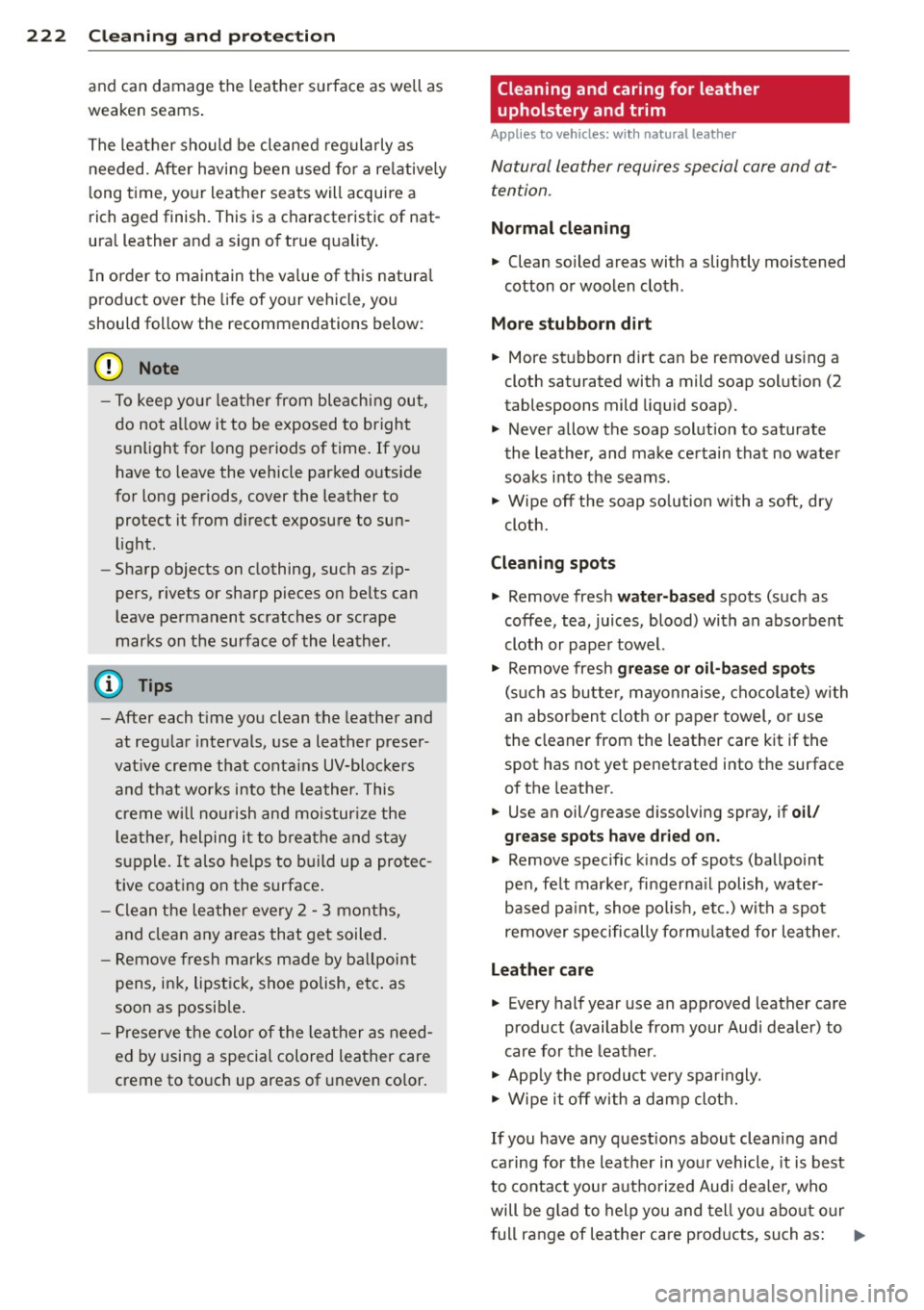
222 Cleaning and protec tio n
and can damage the leather surface as well as
weaken seams .
The leather shou ld be cleaned reg ularly as
needed. After having been used for a re latively
l ong time, your leather seats will acquire a
rich ag ed finish. This is a characteristic of nat
ura l leather and a sign of true quality .
I n order to ma in tain the va lue of th is natura l
p rod uct over the life of your vehicle, you
should follow the recommendations below :
(U;) Note
-To keep your leather from bleaching ou t,
do not a llow it to be exposed to bright
sunlight for long periods of time .
If you
have to leave the vehicle parked outside
for long periods, cover the leather to protect it from d irect exposure to sun
li ght.
- Sharp objects on clothing, such as zip
pers, rivets or sharp pieces on belts can
leave permanent scratches or scrape
marks on the surface of the leather .
(D Tips
-After each t ime you clean the leather and
at regular intervals, use a leather preser
vat ive creme that conta ins UV-blockers
and that works into the leather. This
creme wi ll nourish and moistur ize the
l eather, helping i t to breathe and stay
supple. It also helps to b uild up a protec
tive coating on the surface .
- Clean the leather every 2 -3 months,
and clean any areas that get soiled.
- Remove fresh mar ks made by ba llpoi nt
pens, ink, lipst ick, shoe polish, etc. as
soon as possib le .
- Preserve the colo r of the leather as need
ed by using a special colored leather care
creme to touch up areas of uneven co lor.
Cleaning and caring for leather
upholstery and trim
Appl ies to vehicles : wi th natural lea the r
Natural leather requires special care and at
tention .
Normal cleaning
.. Clean soiled areas with a slightly moistened
cotton or woolen cloth .
More stubborn dirt
.. More stubborn dirt can be remov ed using a
cloth saturated with a mild soap solut ion (2
tablespoons mild liquid soap).
.. Never allow the soap solution to saturate
the leather, and make certain that no water
soaks into the seams .
.. Wipe off the soap so lution with a soft, dry
cloth.
Cle aning spot s
.. Remove fresh wat er-base d spots (suc h as
coffee , tea, juices, blood) with an absorbent
cloth or paper towel.
.. Remove fresh
gre ase or o il-ba sed spot s
(such as butter , mayonnaise, chocolate) with
an absorbent cloth or paper towel, or use
the cleaner from the leather care kit if the
spot has not yet penetrated into the surface
of the leather.
.. Use an oil/grease d issolving spray, if
oil /
gr ease spots ha ve dr ied on.
.. Remove specific k inds of spots (ballpoint
pen, felt marker, fingerna il polish, water
based pa int, shoe polish, etc .) with a spot
remover specifically fo rmu lated for leather.
L e ather care
.. Every half year use an approved leather care
product (available from your Audi dealer) to
care for the leather .
.. App ly the product very spar ingly.
.. Wipe it off with a damp cloth.
If you have any questions about cleaning and
ca ring for the leather in your vehicle, it is best
to contact your authorized Aud i dea ler, who
will be g lad to help you and tell you abo ut o ur
f ull range of leather care products, such as : .,_
Page 225 of 310
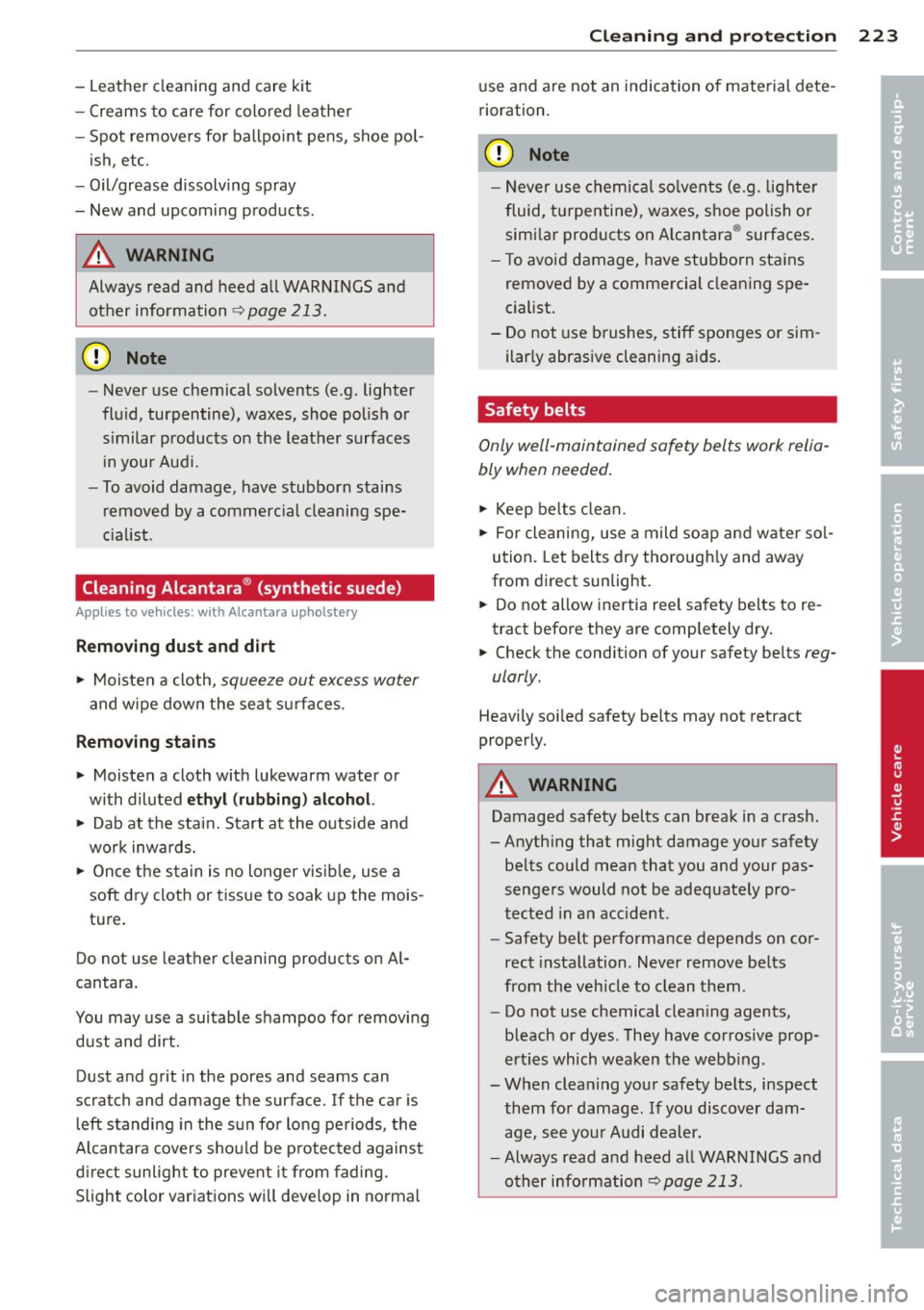
-Leather cleaning and care kit
- Creams to care for colo red leather
- Spot removers fo r ballpo int pens, shoe pol-
ish , etc.
- Oil/grease dissolving spray
- New and upcoming products.
A WARNING
Always read and heed all WARNINGS and
other information ~
page 213.
-Never use chemical solvents (e .g. lighter
flu id , turpentine), waxes, shoe polish or
s imilar products on the leather surfaces
i n your Audi.
- To avoid damage, have stubborn stains
r emoved by a commerc ial cleaning spe
c ia list .
Cleaning Alcantara ® (synthetic suede)
Ap plies to vehicles : wit h Alcanta ra up hols tery
Removing dust and dirt
.,. Moisten a cloth, squeeze out excess water
and wipe down the se at s urfaces .
Removing stains
.,. Moisten a cloth w it h lukewarm water or
with diluted
ethyl (rubb ing) alcoho l.
.,. Dab at the stai n. Start at the outside and
wor k inwards.
.,. Once the s tain is no longer visib le , use a
soft dry cloth or t issue to soak up the mois
tu re .
D o no t use leather cleaning produc ts on Al
cantara .
You may use a suitable s hampoo fo r removi ng
dust and dirt.
Dust and grit in the pores and seams can
scratch and damage the surface . If the car is
l eft standing in the sun fo r long pe riods , the
A lcantara covers sho uld be protected against
d ir ect sunlight to preve nt i t from fading.
Slight color var iat ions w ill deve lop in normal
Cleaning and protec tion 223
use and a re not an indication of material dete
rioration .
(D Note
-Never use chem ic al so lvents (e .g. lighter
fluid , tur pentine), waxes, shoe polish o r
simi lar products on A lcantara ® surfaces.
- To avoid damage, have stub born sta ins
removed by a commercial clean ing spe
cialist .
- Do not use b rushes, sti ff spon ges or sim
ilar ly abrasive cleaning a ids.
Safety belts
Only well-maintained safety belts work relia
bly when needed.
.,. Keep belts clean.
.,. For cleaning, use a mild soap and water so l
ution. Let belts dry thoroug hly and away
from direct sunlight .
.. Do not allow inertia ree l sa fety belts to re
tract before they are completely dry.
.,. Check t he condition of your safety belts reg·
ularly .
Heavi ly so iled safety belts may not retract
proper ly.
A WARNING
Damaged safety belts can break in a crash .
-Anyth ing that might damage your safety
be lts could mea n that you and your pas
sengers would not be adequate ly pro
t e cted in an accide nt.
- Safety belt performance depends on co r
rect installation . Never remove be lts
from the veh icle to clean t hem .
- Do not use chemical clea ning agents,
bleach or dyes . T hey have corrosive prop
erties which wea ken the webb ing .
- When clea ning your safety be lts, inspect
them for damage . If you discover dam
age, see your Audi d ealer.
- Always read a nd heed a ll WAR NINGS and
other information
~ page 213 .
•
•
Page 226 of 310
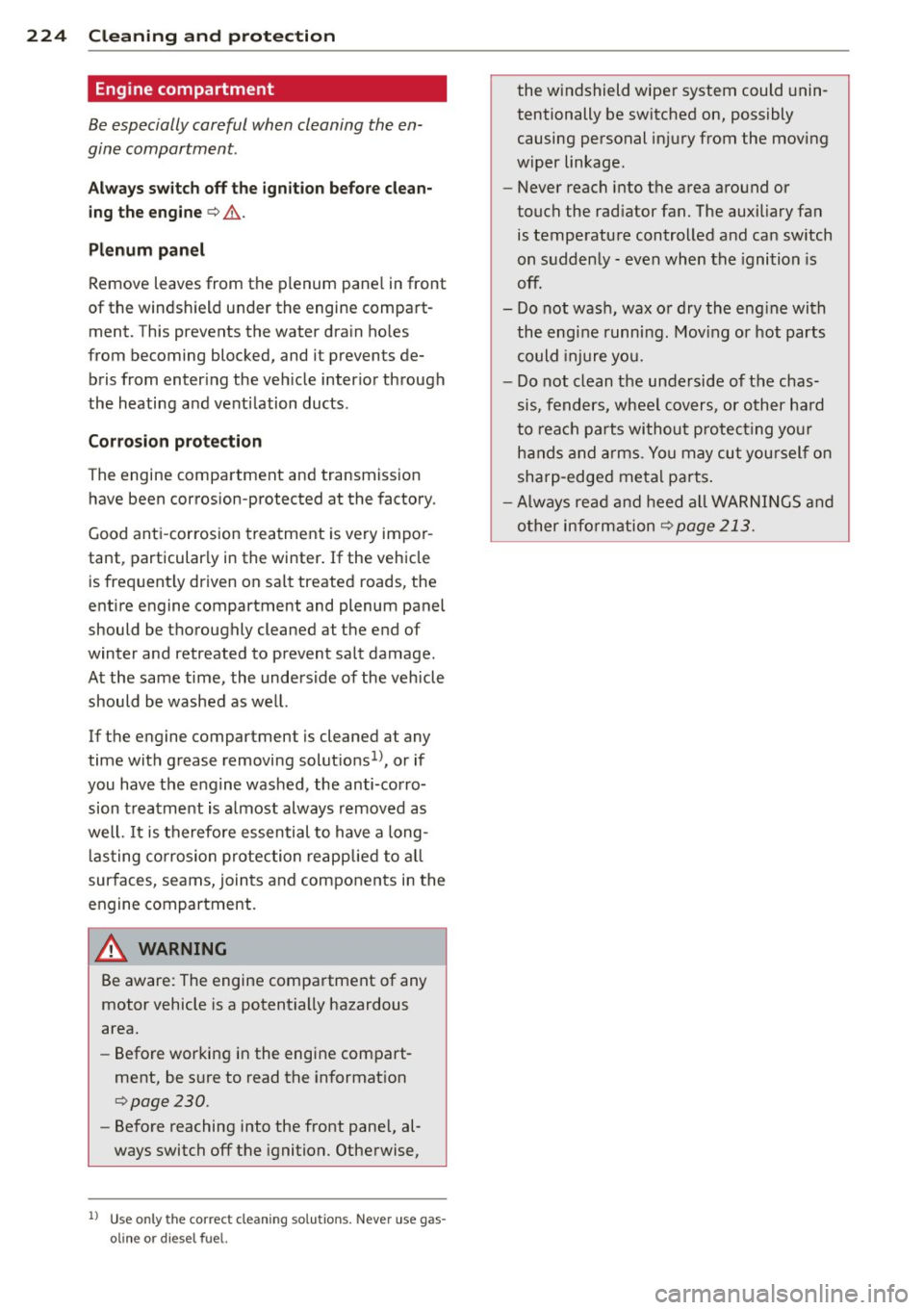
224 Cleaning and protection
Engine compartment
Be especially careful when cleaning the en
gine compartment.
Al way s switch o ff t he ign ition b efore clean
ing the engi ne
c:> &. .
Plenum p ane l
Remove leaves from the plenum pane l in front
of the windshield under the engine compart
ment. This p revents the water drain holes
from becoming blocked, and it preven ts de
bris from enter ing the veh icle inter ior through
the heating and venti lation ducts.
Cor rosion protecti on
The engine compartment and transmission
have been corrosion-protected at the factory.
Good anti -corrosion treatment is very impor
tant, particular ly in the winter. If the vehicle
is frequent ly driven on sa lt treated roads, the
entire engine compartment and plenum panel
should be thoroughly cleaned at the end of
winter and retreated to prevent salt damage .
At the same time, the underside of the vehicle
should be washed as well.
If the engine compartment is cleaned at any
time with grease removing solut ions
1>, or if
you have the engine washed, the anti-corro
sion treatment is a lmost always removed as
well. It is therefore essential to have a long
l asting co rrosion protection reapp lied to all
surfaces, seams, joints and components in the
engine compartment .
&_ WARNING
Be aware: The engine compartment of any
motor vehicle is a potentially hazardous
area.
- Before working in the engine compart
ment, be sure to read the informat ion
c:> page 230.
- Before reaching into the front pane l, al
ways switch off the ignition. Otherwise,
1l Use o nly the co rrect cle anin g so lu ti on s. Never use gas
o lin e or d ie se l fuel.
the windshield wiper system could unin
tentionally be switched on, possibly
causing personal injury from the moving
wiper linkage .
- Never reach into the area around or
touch the rad iator fan. The auxiliary fan
is temperature controlled and can sw itch
on suddenly- even when the ignition is
off.
- Do not wash, wax or dry the eng ine with
the engine running. Mov ing or hot parts
could injure you.
- Do not clean the underside of the chas
sis, fenders, wheel covers, or other hard
to reach parts without protect ing your
hands and arms . You may cut yourself on
sharp-edged metal parts .
- Always read and heed all WARNINGS and
other info rmation
c:> page 213.
Page 227 of 310
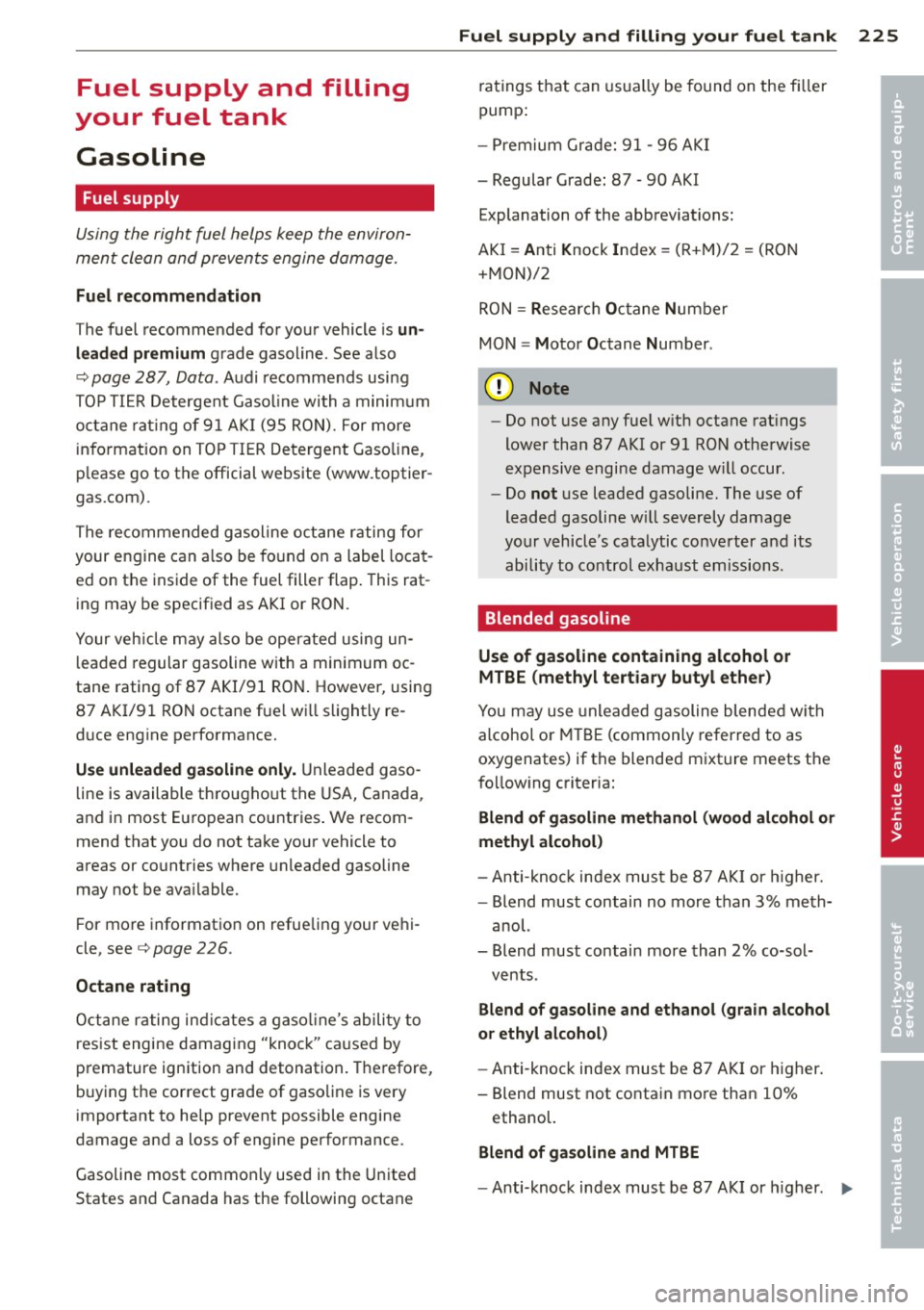
Fuel supply and filling
your f uel tank
Gasoline
Fuel supply
Using the right fuel helps keep the environ
ment clean and prevents engine damage.
Fuel recommendation
The fuel recommended for you r vehicle is un
leaded premium
g rade gasolin e. See also
¢ page 287, Data . Audi recommends usi ng
TO P TI ER Deterge nt Gaso line wi th a minim um
oc ta ne ra ti ng of 9 1 AK I (9 5 RON). For more
in fo rmation on TO P TI ER De tergent Gaso line,
p lease go to the official website (www.toptier
gas.com).
The re commended g asoline octane r ating for
your engine can a lso be fo und o n a label loca t
e d on the ins ide of the fuel filler flap . This rat
ing may be specif ied as A KI or RO N.
Your veh icle m ay also be oper ated using un
l e aded regular gasoline with a minimum oc
tane rating of 87 AKI/91 RON . However, using
87 AKI/9 1 RO N octa ne f ue l w ill sli ghtly re
d uce eng ine perfo rmance .
Use unleaded gasoline only. Unleaded gaso
line is available th rougho ut the USA, Canada,
a nd in most E uropean cou ntries . We recom
mend that you do not ta ke yo ur vehicle to
areas or count ries where unleaded gasoline
may not be ava ilable.
F or mo re informat io n on refue ling your ve hi
cle, see ¢
page 226.
Octane rating
Octane r ati ng in dicates a gaso line's abili ty to
r es ist engine damaging "knock" ca used by
p remature ign ition and detonation. Therefore,
buy ing the correct grade of gaso line is very
i mportant to help prevent possible engine
damage and a loss of engine performance.
Gasoline most common ly used in the Unite d
States and Canada has the followin g octane
Fuel supply and filling your fuel tank 225
ra tings that can usu a lly be found on the fi ller
p ump :
- Premium Gr ade: 9 1 -9 6 AKI
- Regular Grade : 87 -90 AKI
Explanation of the abbreviations:
AKI = Anti K nock In d ex = (R+M )/2 = (RO N
+M ON)/2
RON= Resear ch O ctane Num ber
MO N= Motor Octane Number.
(D Note
- Do not use a ny fue l w it h octane rat ings
lower than 87 A KI or 9 1 RO N othe rwise
e xpensive engi ne damage w ill occur.
- Do
not use leaded gasoli ne . The use of
leaded gasolin e w ill severely damage
yo ur vehicl e's cata lytic co nve rter and its
ability to control exh aust em iss ions.
Blended gasoline
U se of gasoline containing alcohol or
MTBE (methyl tertiary butyl ether)
You may use unleaded g asoline blende d with
a lcohol o r MTBE (commonly re fer red to as
oxygenates) if the blende d mixture meets the
fo llow ing criteria:
Blend of gasoline methanol (wood alcohol or
methyl alcohol)
- Anti -kno ck index mus t be 87 A KI or higher.
- Blend must contain no mor e than 3% meth-
anol.
- Blend must co ntain more than 2% co-sol-
vents .
Blend of gasoline and ethanol (grain alcohol
or ethyl alcohol)
- Anti -knoc k index must be 87 A KI or higher.
- Blend must not conta in mo re tha n 10%
ethanol.
Blend of gasoline and MTBE
- Anti -knoc k index must be 87 AKI or higher . ll>-
•
•
Page 228 of 310
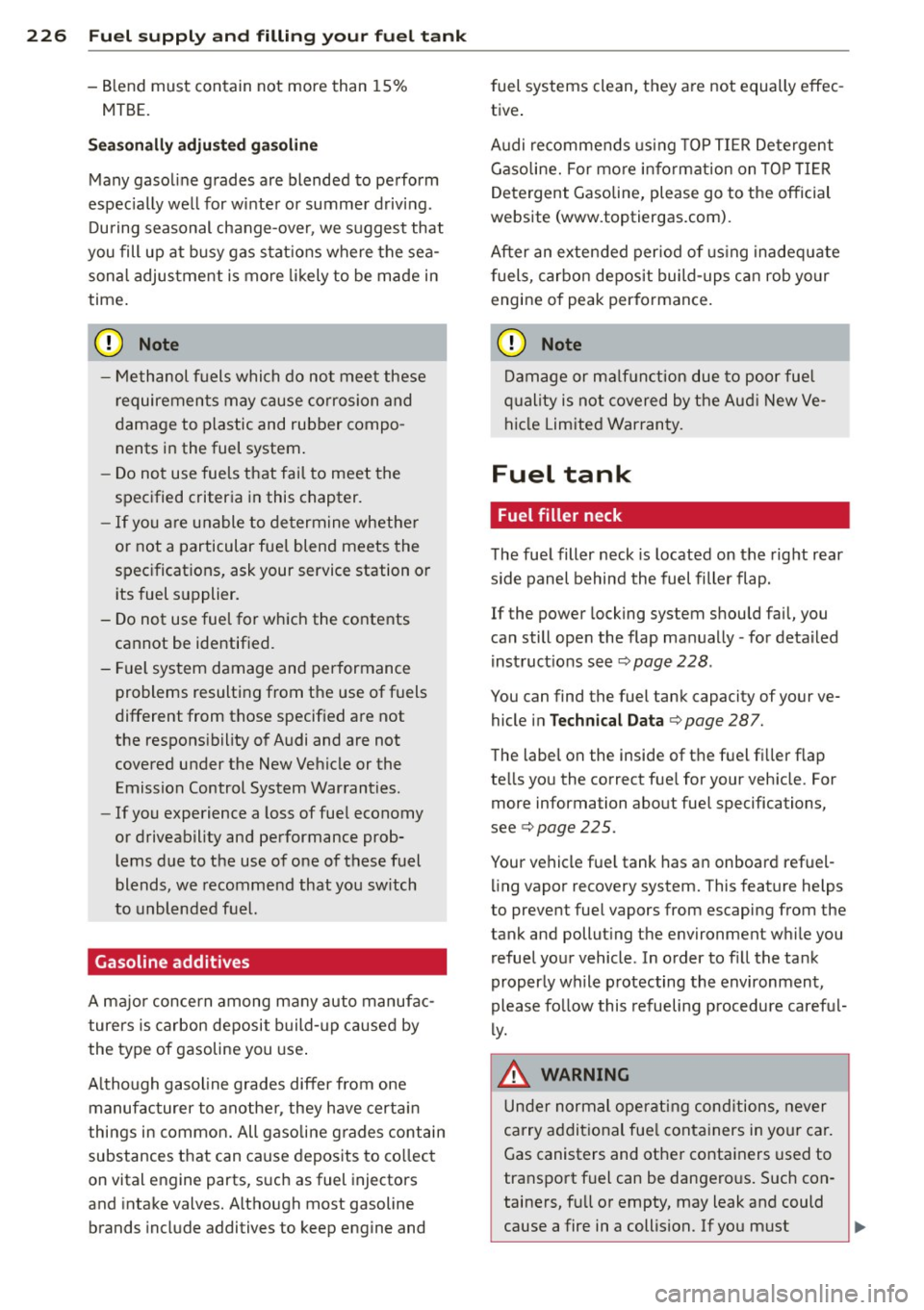
226 Fuel supply and filling your fuel tank
-Blend must contain not more than 15%
MTBE.
Seasonally adjusted gasoline
Many gasoline grades are blended to perform
espec ially we ll for winter or summer driv ing.
During seasonal change-over, we suggest that
you fill up at busy gas stat ions where the sea
sonal adjustment is more likely to be made in
time.
(CT) Note
- Methanol fuels which do not meet these
requirements may cause corrosion and
damage to plastic and rubber compo
nents in the fuel system .
- Do not use fuels that fai l to meet the
specified criteria in this chapter.
- If yo u are unable to determine whether
or not a particular fuel blend meets the
specifications, ask your service station or
its fuel sup plier.
- Do not use fuel for which the contents cannot be identified.
- Fuel system damage and performance
problems resulting from the use of fuels
different from those specified are not
the respons ibility of Audi and are not
covered under the New Vehicle or the Emission Control System Warranties.
- If you experience a loss of fuel economy
or driveability and performance prob l ems due to the use of one of these fuel
blends, we recommend that you switch
to unblended fuel.
Gasoline additives
A major concern among many auto manufac
turers is carbon deposit build- up caused by
the type of gasoline you use.
A lthough gasoline grades differ from one
manufacturer to another, they have certain
things in common. All gasoline g rades contain
substances that can cause deposits to co llect
on vital engine parts, such as fuel injectors
and intake valves. Although most gasoline
brands include additives to keep engine and fuel
systems clean, they a re not equally effec
tive .
A udi recommends using TOP TIER Detergent
Gasoline. For more information on TOP TIER
Detergent Gasoline, please go to the official
website (www.toptiergas.com).
After an extended period of using inadequate
f uels, carbon deposit build-ups can rob yo ur
engine of peak performance.
(D Note
'
Damage or malf u nct ion due to poor fuel
quality is not covered by the Aud i New Ve
hicle Limited Warranty.
Fuel tank
Fuel filler neck
The fuel filler neck is located on the right rear
s ide panel behind the fuel filler flap.
If the power locking system should fail, you
can still open the flap manually- for detailed
instructions see¢
page 228 .
You can find the fuel tank capacity of your ve
hicle in
Technical Data ¢ page 287.
The label on the inside of the fuel fi ller flap
tells you the correct fue l for your veh icle. For
more information about fuel specifications,
see ¢
page 225.
Your vehicle fuel tank has an on board refuel
li ng vapor recovery system. This feature helps
to prevent fuel vapors from escaping from the
tank and polluting the environment while you refuel your vehicle . In order to fill the tank
properly wh ile protecting the environment,
please fo llow this refueling procedure careful
ly.
.8, WARNING
Under normal operating cond itions, never
carry additional fuel containers in your car.
Gas canisters and other containers used to
transport fuel can be dangerous. Such con
tainers, full or empty, may leak and could
cause a fire in a collision. If you must
Page 229 of 310
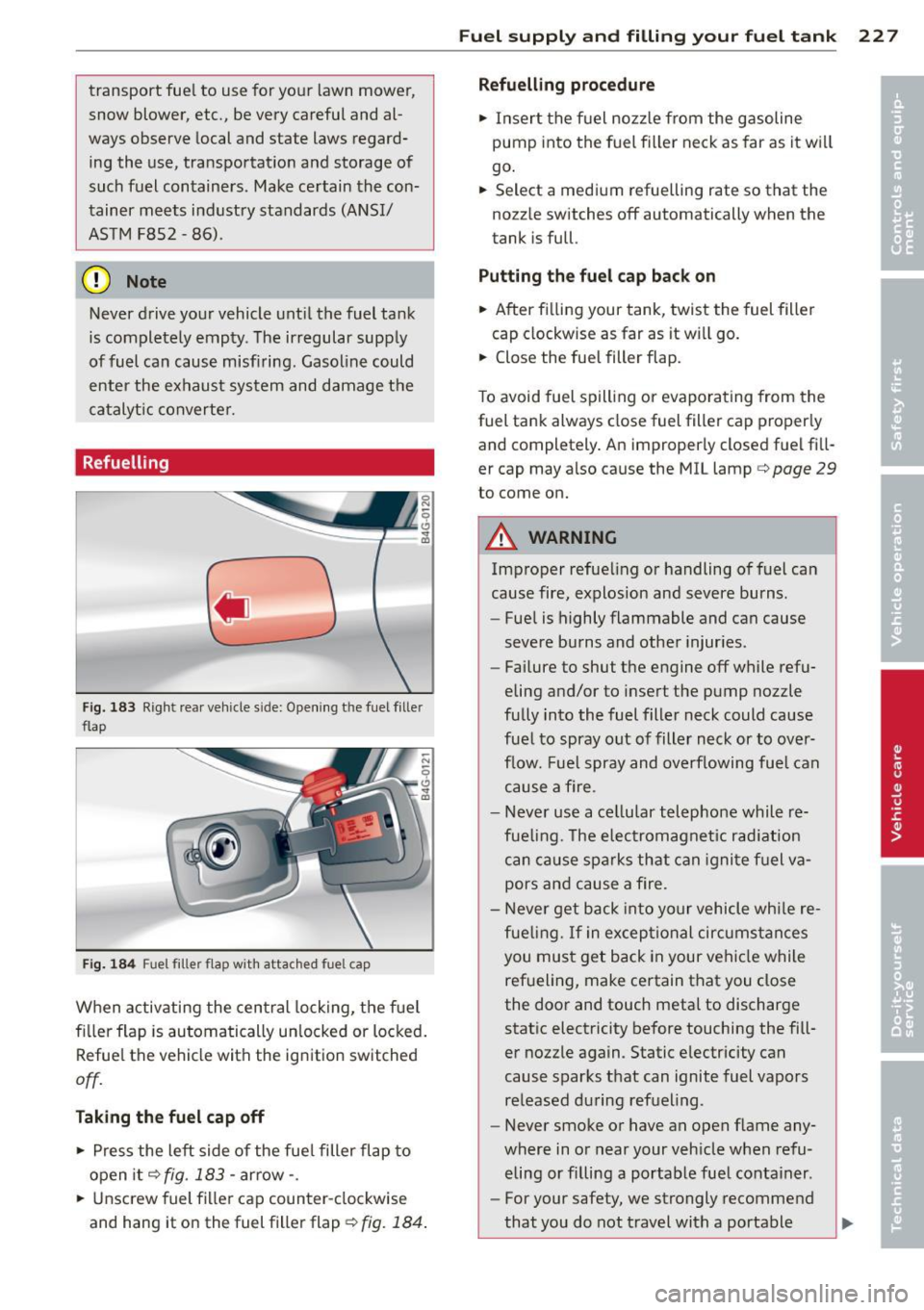
transport fuel to use for your lawn mower,
snow blower, etc., be very careful and al
ways observe local and state laws regard
ing the use, transportation and storage of
such fuel containers. Make certain the con
tainer meets industry standards (ANSI/
ASTM F8S2 -86) .
@ Note
Never drive your vehicle until the fuel tank
is completely empty. The irregular supply
of fuel can cause misfiring. Gasoline could
enter the exhaust system and damage the
catalyt ic converter.
Refuelling
Fig. 183 Right rear vehicle s ide: Opening the fuel filler
flap
Fig. 184 Fuel filler flap with attached fuel cap
When activating the central locking, the fuel
f ill er flap is automatically un locked or locked.
Refuel the vehicle with the ignition switched
off.
Taking the fuel cap off
• Press the left side of the fuel filler flap to
open it¢
fig. 183 -arrow-.
• Unscrew fuel filler cap counter-clockwise
and hang it on the fuel filler flap~
fig. 184.
Fuel supply and filling your fuel tank 22 7
Refuelling procedure
• Insert the fuel nozzle from the gasoline
pump into the fuel filler neck as far as it will
go.
• Select a medium refuelling rate so that the
nozzle switches off automatically when the
tank is full.
Putting the fuel cap back on
• After filling your tank, twist the fuel filler
cap clockwise as far as it will go.
• Close the fuel filler flap.
To avoid fuel spill ing or evaporating from the
fuel tank always close fuel filler cap proper ly
and completely. An improperly closed fuel fill
er cap may also cause the MIL lamp ¢
page 29
to come on.
A WARNING
Improper refueling or handling of fuel can
cause fire, explosion and severe burns.
- Fuel is highly flammable and can cause
severe burns and other injuries.
- Failure to shut the engine off while refu
eling and/or to insert the pump nozzle
fully into the fuel filler neck could cause
fue l to spray out of filler neck or to over
flow. Fuel spray and overflowing fuel can
cause a fire.
- Never use a cellular telephone while re
fue ling. The electromagnet ic rad iation
can cause sparks that can ignite fuel va
pors and cause a fire.
- Never get back into your vehicle while re
fueling.
If in exceptional circumstances
you must get back in your vehicle while
refueling, make certain that you close
the door and touch metal to discharge static electricity before touching the fill
er nozzle again. Static electricity can
cause sparks that can ignite fuel vapors
released during refueling.
- Never smoke or have an open flame any
where in or near your vehicle when refu
eling or filling a portable fue l container.
- For your safety, we strongly recommend
that you do not travel with a portable
Page 230 of 310
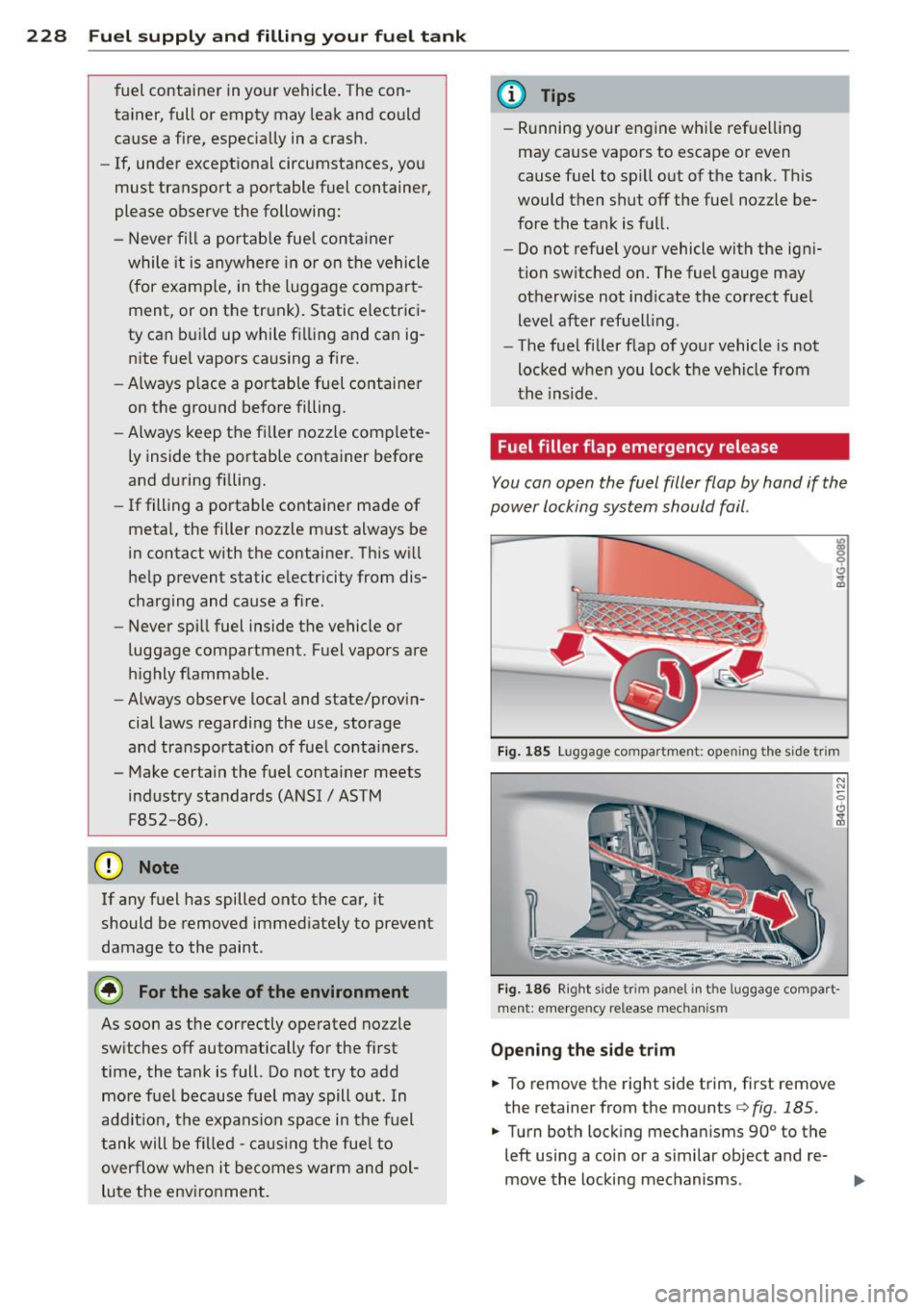
228 Fuel supply and filling your fuel tank
fuel container in your vehicle. The con
tainer, full or empty may leak and could
cause a fire, especially in a crash.
- If, under exceptional circumstances, you
must transport a portable fuel container,
please observe the following:
- Never fill a portable fuel container
while it is anywhere in or on the vehicle
(for example, in the luggage compart
ment, or on the trunk). Static electrici
ty can bui ld up while filling and can ig
nite fuel vapors causing a fire .
- Always place a portable fuel container
on the ground before filling.
- Always keep the filler nozzle complete
ly inside the portable container before
and during filling.
- If filling a portable container made of
metal, the filler nozz le must always be
in contact with the container. This will
help prevent static electricity from dis
charging and cause a fire .
- Never spill fuel inside the vehicle or
luggage compartment. Fuel vapors are
highly flammable.
- Always observe local and state/provin
cial laws regarding the use, storage
and transportation of fuel conta iners .
- Make certain the fuel container meets
industry standards (ANSI/ ASTM
F8S2 -86) .
d) Note
If any fuel has spilled onto the car, it
should be removed immediately to prevent
damage to the paint.
@ For the sake of the environment
As soon as the correctly operated noz zle
switches off automatically for the first
time, the tank is full. Do not try to add
more fuel because fuel may spill out. In
addition, the expansion space in the fuel
tank will be filled -causing the fuel to
overflow when it becomes warm and pol
lute the environment.
(D Tips
-Running your engine whi le refue lling
may cause vapors to escape or even
cause fuel to spi ll out of the tank. This
would then shut off the fuel nozzle be
fore the tank is full.
- Do not refuel your vehicle with the igni
tion switched on. The fuel gauge may otherwise not ind icate the correct fuel
level after refuelling .
- The fuel filler flap of your vehicle is not
locked when you lock the vehicle from
the ins ide .
Fuel filler flap emergency release
You can open the fuel filler flap by hand if the
power locking system should fail.
Fig. 185 Lug g ag e compar tmen t: o pe ning th e side tri m
N
N
0 <.:)
iii
Fig. 186 Rig ht s ide t rim p an el in t he luggage compart
ment : emer gen cy re lease mech anism
Opening the side trim
.. To r emove th e right side trim, first remove
the retainer from the mounts
¢ fig . 185.
.. Turn both locking mechanisms 90° to the
left using a coin or a similar object and re-
move the locking mechanisms. ..,_